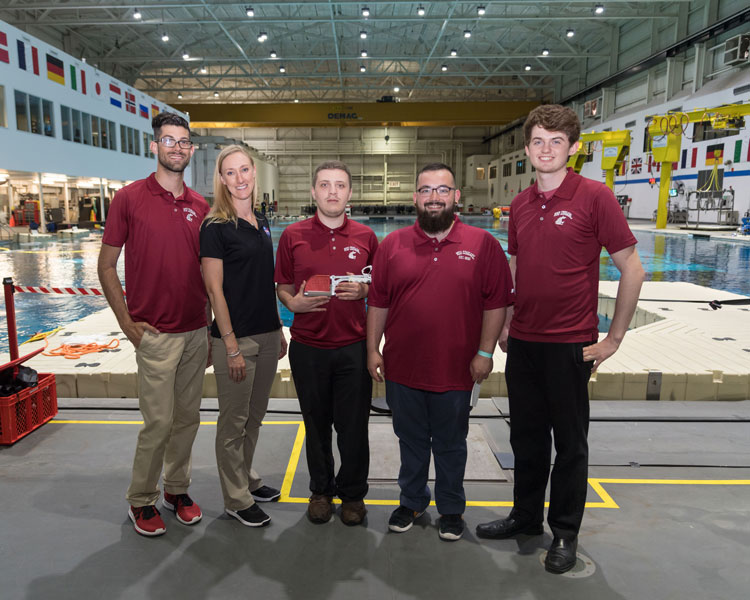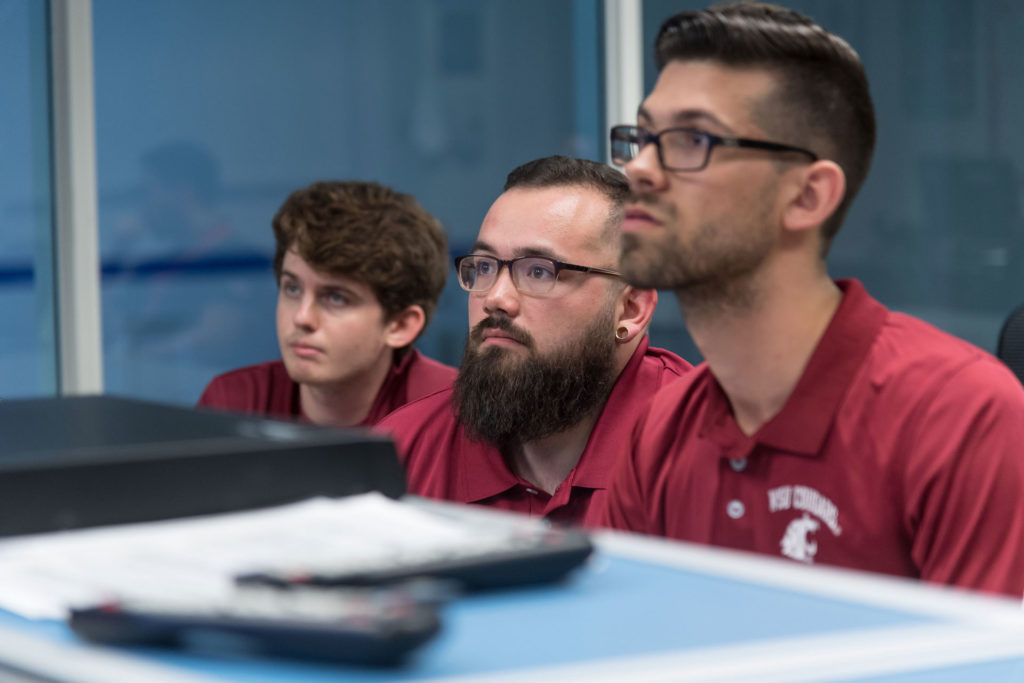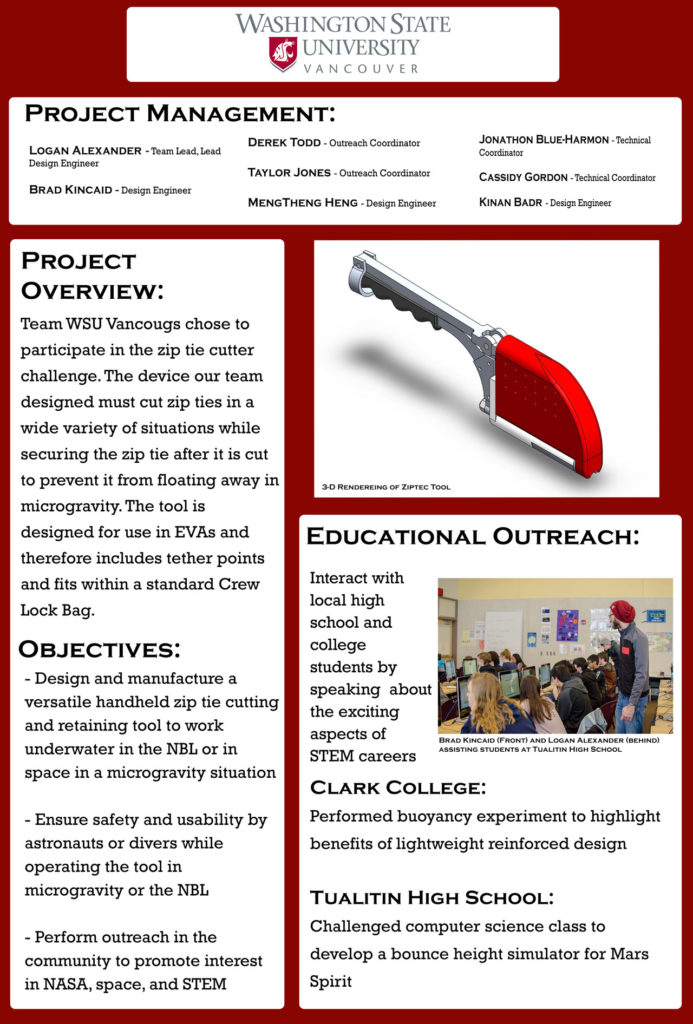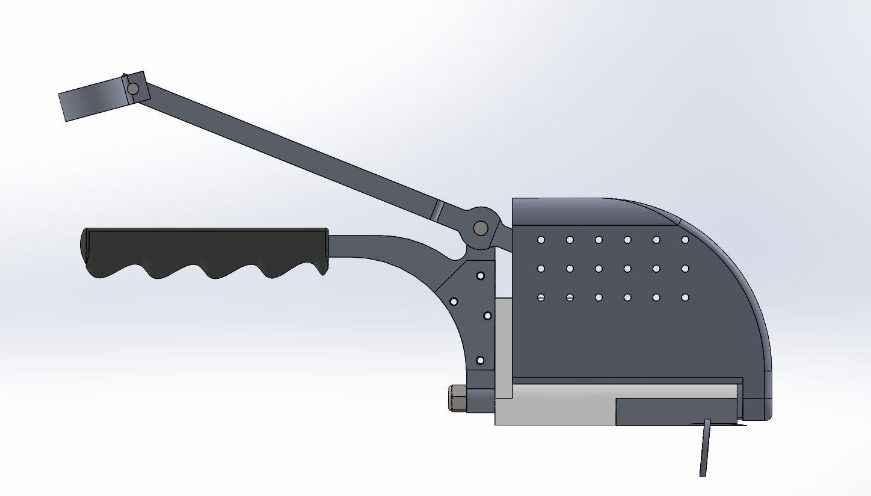
PartsBadger makes machined parts for a diverse group of individuals, companies, and markets. This story focuses on the next generation of engineers at Washington State University Vancouver (WSUV). We had the privilege to work with a talented team, team WSU Vancougs. They participated in the WSUV Micro-g Buoyancy Experiment Design Teams (Micro-g NExT) Challenge1. The Micro-g NExT challenge is designed for undergraduate students to design build and test a tool or device to address a current space exploration challenge. Put forth by NASA, teams propose, prototype, and test their tool or device with professional Neutral Buoyancy Laboratory NBL divers.
ZIP-Tie Cutter (ZIP-TEC) Removal and Retrieval System
Challenges
 Team WSU Vancougs faced a few challenges along the way to testing their design. Their project began with a proposed conceptual design to be approved by NASA. After approval, a new set of challenge requirements were released causing a redesign of their original concept. Additional challenges included:
Team WSU Vancougs faced a few challenges along the way to testing their design. Their project began with a proposed conceptual design to be approved by NASA. After approval, a new set of challenge requirements were released causing a redesign of their original concept. Additional challenges included:
- Unfamiliarity with the machining process
- Outreach through community events and local school visits
- Lack of funding
Solutions
 After receiving the new challenge requirement from NASA, Team WSU Vancougs went back to the drawing board. They realized that their original design was more difficult to machine, so they designed a more efficient product. The experience provided the team a valuable opportunity to learn about the machining process in terms of designing original parts. Funding also posed a threat to the success of their project. Through outreach and ingenuity they were able to create their minimum viable product. Team lead Logan Alexander says, “We asked around local scrap yards in Portland, OR for metal which we could machine into our parts but PartsBadger really made the machining operation very simple and I am glad we got the parts machined through PartsBadger.”
After receiving the new challenge requirement from NASA, Team WSU Vancougs went back to the drawing board. They realized that their original design was more difficult to machine, so they designed a more efficient product. The experience provided the team a valuable opportunity to learn about the machining process in terms of designing original parts. Funding also posed a threat to the success of their project. Through outreach and ingenuity they were able to create their minimum viable product. Team lead Logan Alexander says, “We asked around local scrap yards in Portland, OR for metal which we could machine into our parts but PartsBadger really made the machining operation very simple and I am glad we got the parts machined through PartsBadger.”
The parts supplied by PartsBadger made up the entirety of the cutting and zip-tie actuation mechanism. Team WSU Vancougs chose PartsBadger after learning the company has a reputation for low lead times on very precise components and that the company offers solutions to other college groups.
Results and Future Plans
 An improper design of tolerances in the rotating components caused a very cumbersome tolerance stacking which Team WSU Vancougs did not account for. The cutting mechanism required immense force to actuate and ended up breaking the cables during the test. The device was testing for ergonomics and the ability to fit within the testing environment. These, I consider to be a success. All components, however, were machined to spec and this was entirely the fault of the engineering involved.
An improper design of tolerances in the rotating components caused a very cumbersome tolerance stacking which Team WSU Vancougs did not account for. The cutting mechanism required immense force to actuate and ended up breaking the cables during the test. The device was testing for ergonomics and the ability to fit within the testing environment. These, I consider to be a success. All components, however, were machined to spec and this was entirely the fault of the engineering involved.
This taught the team a very important lesson, that more than just function and aesthetics needs to be taken into account when designing products, especially for human use. In the future, a greater design for machining and assembly will be taken into consideration. Team WSU Vancougs learned a lot since the experiment has taken place and Logan looks forward to working with PartsBadger in the future.
Here’s a video that Team WSU Vancougs shared with us displaying their product:
Appendix:
Editor’s note: Team WSU Vancougs team lead Logan Alexander, pictured at top on the far-right, is co-author of this article.
Team members of WSU Vancougs:
- Logan Alexander – Team Lead, Lead Design Engineer
- Brad Kincaid – Design Engineer
- MengTheng Heng – Design Engineer
- Kinan Badr – Design Engineer
- Derek Todd – Outreach Coordinator
- Taylor Jones – Outreach Coordinator
- Jonathon Blue-Harmon – Technical Coordinator
- Cassidy Gordon – Technical Coordinator
Team WSU Vancougs project references:
Article references:
-
- Micro-g Buoyancy Experiment Design Teams (Micro-g NExT) Challenge: https://microgravityuniversity.jsc.nasa.gov/about-micro-g-next.cfm

Recent Comments